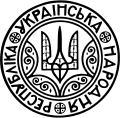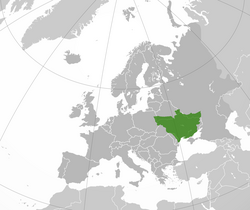| History of Ukraine |
|---|
 |
The Ukrainian People's Republic (UPR)[d][e] was a short-lived state in Eastern Europe. Prior to its proclamation, the Central Council of Ukraine was elected in March 1917 as a result of the February Revolution, and in June, it declared Ukrainian autonomy within Russia. Its autonomy was later recognized by the Russian Provisional Government. Following the October Revolution, the Central Council of Ukraine denounced the Bolshevik seizure of power and proclaimed the Ukrainian People's Republic with a territory including the area of approximately eight Russian imperial governorates (Kiev, Volhynia, Kharkov, Kherson, Yekaterinoslav, Poltava, Chernigov and Podolia). It formally declared its independence from Russia on 22 January 1918.
During its short existence, the republic went through several political transformations – from the socialist-leaning republic headed by the Central Council of Ukraine with its general secretariat, to the socialist republic led by the Directorate and by Symon Petliura. Between April and December 1918, the socialist authority of the Ukrainian People's Republic was suspended, having been overthrown by the pro-German Ukrainian State of Pavlo Skoropadskyi, who was elected as the Hetman of Ukraine by a congress of peasants.[2][3][need quotation to verify] After the collapse of the Ukrainian State, the Ukrainian People's Republic declared its unification with the West Ukrainian People's Republic in January 1919. After the Polish–Ukrainian War, it signed an alliance with the Second Polish Republic. On 10 November 1920, the state lost the remainder of its territory to the Bolsheviks. The Peace of Riga on 18 March 1921 between Poland, Soviet Russia (acting also on behalf of Soviet Belarus), and Soviet Ukraine sealed the fate of the Ukrainian People's Republic.
After the October Revolution, many governments formed in the territory of Ukraine, most notably the Ukrainian People's Republic of Soviets based in Kharkov, and its Soviet successors. This force, along with the Ukrainian People's Republic, the White movement, Poland, Green armies, and anarchists, fought constantly with each other, which resulted in many casualties among Ukrainians fighting in the Ukrainian War of Independence as part of the wider Russian Civil War of 1917–1923. Soviet Russia would extend its control over what would ultimately become the Ukrainian Soviet Socialist Republic, which became a founding member of the Soviet Union in 1922.[2]
Cite error: There are <ref group=lower-alpha> tags or {{efn}} templates on this page, but the references will not show without a {{reflist|group=lower-alpha}} template or {{notelist}} template (see the help page).
- ^ Directory (Ukrainian ruling body) at the Encyclopædia Britannica
- ^ a b Yekelchyk 2007.
- ^ Europa Publications (1999). Eastern Europe and the Commonwealth of Independent States, 1999. Taylor & Francis. p. 849. ISBN 978-1-85743-058-5.



